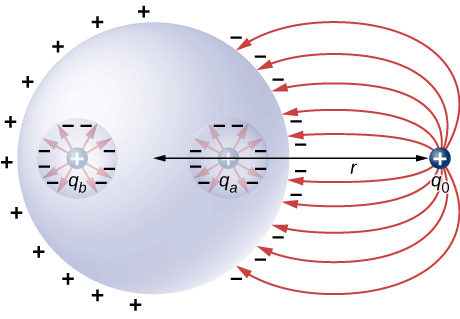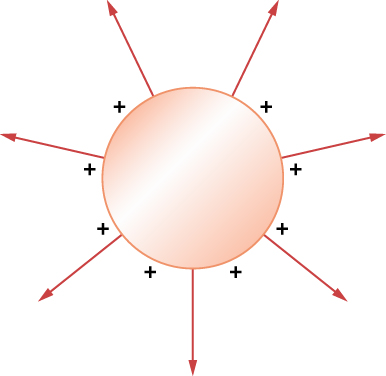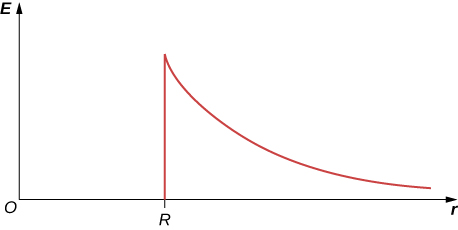8: Gauss's Law (Answers)
- Last updated
- Mar 8, 2021
- Save as PDF
- Page ID
- 33501
( \newcommand{\kernel}{\mathrm{null}\,}\)
Check Your Understanding
6.1. Place it so that its unit normal is perpendicular to →E.
6.2. mab2/2
6.3 a. 3.4×105N⋅m2/C;
b. −3.4×105N⋅m2/C;
c. 3.4×105N⋅m2/C;
d. 0
6.4. In this case, there is only →Eout. So,yes.
6.5. →E=λ02πε01dˆr; This agrees with the calculation of Example 5.5 where we found the electric field by integrating over the charged wire. Notice how much simpler the calculation of this electric field is with Gauss’s law.
6.6. If there are other charged objects around, then the charges on the surface of the sphere will not necessarily be spherically symmetrical; there will be more in certain direction than in other directions.
Conceptual Questions
1. a. If the planar surface is perpendicular to the electric field vector, the maximum flux would be obtained. b. If the planar surface were parallel to the electric field vector, the minimum flux would be obtained.
3. true
5. Since the electric field vector has a 1r2 dependence, the fluxes are the same since A=4πr2.
7. a. no;
b. zero
9. Both fields vary as 1r2. Because the gravitational constant is so much smaller than 14πε0, the gravitational field is orders of magnitude weaker than the electric field.
11. No, it is produced by all charges both inside and outside the Gaussian surface.
13. No, since the situation does not have symmetry, making Gauss’s law challenging to simplify.
15. Any shape of the Gaussian surface can be used. The only restriction is that the Gaussian integral must be calculable; therefore, a box or a cylinder are the most convenient geometrical shapes for the Gaussian surface.
17. yes
19. Since the electric field is zero inside a conductor, a charge of −2.0μC is induced on the inside surface of the cavity. This will put a charge of +2.0μC on the outside surface leaving a net charge of −3.0μC on the surface.
Problems
21. Φ=→E⋅→A→EAcosθ=2.2×104N⋅m2/C electric field in direction of unit normal; Φ=→E⋅→A→EAcosθ=−2.2×104N⋅m2/C electric field opposite to unit normal
23. 3×10−5N⋅m2/C(0.05m)2=E⇒σ=2.12×10−13C/m2
25. a. Φ=0.17N⋅m2/C;
b. Φ=0;
c. Φ=EAcos0°=1.0×103N/C(2.0×10−4m)2cos0°=0.20N⋅m2/C
27. Φ=3.8×104N⋅m2/C
29. →E(z)=14πε02λzˆk,∫→E⋅ˆndA=λε0l
31. a. Φ=3.39×103N⋅m2/C;
b. Φ=0;
c. Φ=−2.25×105N⋅m2/C;
d. Φ=90.4N⋅m2/C
33. Φ=1.13×106N⋅m2/C
35. Make a cube with q at the center, using the cube of side a. This would take four cubes of side a to make one side of the large cube. The shaded side of the small cube would be 1/24th of the total area of the large cube; therefore, the flux through the shaded area would be Φ=124qε0.
37. q=3.54×10−7C
39. zero, also because flux in equals flux out
41. r>R,E=Q4πε0r2;r<R,E=qr4πε0R3
43. EA=λlε0⇒E=4.50×107N/C
45. a. 0;
b. 0;
c. →E=6.74×106N/C(−ˆr)
47. a. 0;
b. E=2.70×106N/C
49. a. Yes, the length of the rod is much greater than the distance to the point in question.
b. No, The length of the rod is of the same order of magnitude as the distance to the point in question.
c. Yes, the length of the rod is much greater than the distance to the point in question.
d. No. The length of the rod is of the same order of magnitude as the distance to the point in question.
51. a. →E=Rσ0ε01rˆr⇒σ0=5.31×10−11C/m2,λ=3.33×10−12C/m;
b. Φ=qencε0=3.33×10−12C/m(0.05m)ε+0=0.019N⋅m2/C
53. E2πrl=ρπr2lε0⇒E=ρr2ε0(r≤R);E2πrl=ρπR2lε0⇒E=ρR22ε0r(r≥R)
55. Φ=qencε0⇒qenc=−1.0×10−9C
57. qenc=45παr5,E4πr2=4παr55ε0⇒E=αr35ε0(r≤R),qenc=45παR5,E4πr2=4παR55ε0⇒E=αR55ε0r2(r≥R)
59. integrate by parts: qenc=4πρ0[−e−αr((r)2α+2rα2+2α3)+2α3]⇒E=ρ0r2ε0[−e−αr((r)2α+2rα2+2α3)+2α3]
61.

63. a. Outside: E2πrl=λlε0⇒E=3.0C/m2πε0r; Inside Ein=0;
b.

65. a. E2πrl=λlε0⇒E=λ2πε0rr≥R E inside equals 0;
b.

67. E=5.65×104N/C
69. λ=λlε0⇒E=aσε0rr≥a,E=0 inside since q enclosed=0
71. a. E=0;
b. E2πrL=Qε0⇒E=Q2πε0rL; c. E=0 since r would be either inside the second shell or if outside then q enclosed equals 0.
Additional Problems
73. ∫→E⋅ˆndA=a4
75. a. ∫→E⋅ˆndA=E0r2π; b. zero, since the flux through the upper half cancels the flux through the lower half of the sphere
77. Φ=qencε0; There are two contributions to the surface integral: one at the side of the rectangle at x=0 and the other at the side at x=2.0m; −E(0)[1.5m2]+E(2.0m)[1.5m2]=qencε0=−100Nm2/C
where the minus sign indicates that at x=0, the electric field is along positive x and the unit normal is along negative x. At x=2, the unit normal and the electric field vector are in the same direction: qenc=ε0Φ=−8.85×10−10C
79. didn’t keep consistent directions for the area vectors, or the electric fields
81. a. σ=3.0×10−3C/m2,+3×10−3C/m2 on one and −3×10−3C/m2 on the other;
b. E=3.39×108N/CE=3.39×108N/C
83. Construct a Gaussian cylinder along the z-axis with cross-sectional area A.
|z|≥a2qenc=ρAa,Φ=ρAaε0⇒E=ρa2ε0,
|z|≤a2qenc=ρA2z,E(2A)=ρA2zε0⇒E=ρzε0
85. a. r>b2 E4πr2=43π[ρ1(b31−a31)+ρ2(b32−a32)ε0⇒E=ρ1(b31−a31)+ρ2(b32−a32)3ε0r2;
b. a2<r<b2 E4πr2=43π[ρ1(b31−a31)+ρ2(r3−a32)]ε0⇒E=ρ1(b31−a31)+ρ2(r3−a32)3ε0r2;
c. b1<r<a2 E4πr2=43πρ1(b31−a31)ε0⇒E=ρ1(b31−a31)3ε0r2;
d. a1<r<b1 E4πr2=43πρ1(r3−a31)ε0⇒E=ρ1(r3−a31)3ε0r2;
e. 0
87. Electric field due to plate without hole: E=σ2ε0.
Electric field of just hole filled with \(\displaystyle −σE=\frac{−σ}{2ε_0}(1−\frac{z}{\sqrt{R^2+z^2}}).
Thus, Enet=σ2ε0h√R2+h2
89. a. E=0; b. E=q14πε0r2; c. E=q1+q24πε0r2; d. 0 q1−q1,q1+q2
Challenge Problems
91. Given the referenced link, using a distance to Vega of 237×1015m4 and a diameter of 2.4 m for the primary mirror,5 we find that at a wavelength of 555.6 nm, Vega is emitting 2.44×1024J/s at that wavelength. Note that the flux through the mirror is essentially constant.
93. The symmetry of the system forces →E to be perpendicular to the sheet and constant over any plane parallel to the sheet. To calculate the electric field, we choose the cylindrical Gaussian surface shown. The cross-section area and the height of the cylinder are A and 2x, respectively, and the cylinder is positioned so that it is bisected by the plane sheet. Since E is perpendicular to each end and parallel to the side of the cylinder, we have EA as the flux through each end and there is no flux through the side. The charge enclosed by the cylinder is σA, so from Gauss’s law, 2EA=σAε0, and the electric field of an infinite sheet of charge is
E=σ2ε0, in agreement with the calculation of in the text.
95. There is Q/2 on each side of the plate since the net charge is Q:σ=Q2A,
∮S→E⋅ˆndA=2σΔAε0⇒EP=σε0=Qε02A


